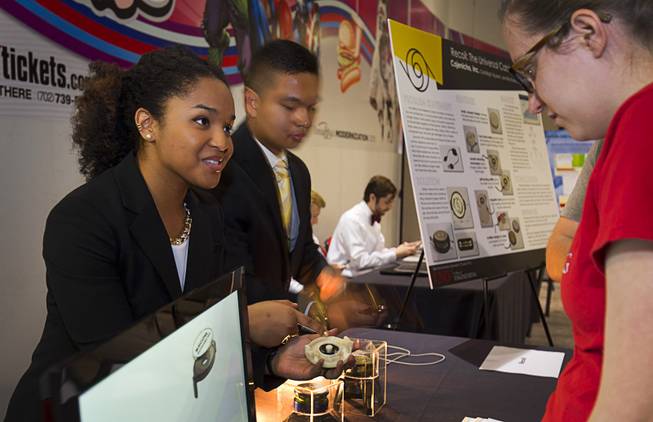
Jennifer Bateau, left, shows the Recoil to graduate student Shelby Nelson during the Fred and Harriet Cox Senior Design Competition at UNLV Thursday, May 7, 2015. The Recoil allows smartphone owners use the cable that comes with the phone and turn it into a retractable cable.
Friday, May 8, 2015 | 2 a.m.
A table that lifts itself up at the push of a button, a handheld device that protects fragile phone chargers, a drone that detects pollution, a gigantic 2,500 foot water slide and a robot that automatically detects intruders.
Those are just a few examples of what UNLV’s engineering graduating students came up with this year for the school’s annual Senior Design Competition.
The competition, which is mandatory for seniors, lasts all year and challenges each student to design and manufacture something that solves a real-world problem. On Thursday the students finally got a chance to showcase their designs to the public at the Cox Pavilion.
Here are a few that stood out:
AdjusTABLE
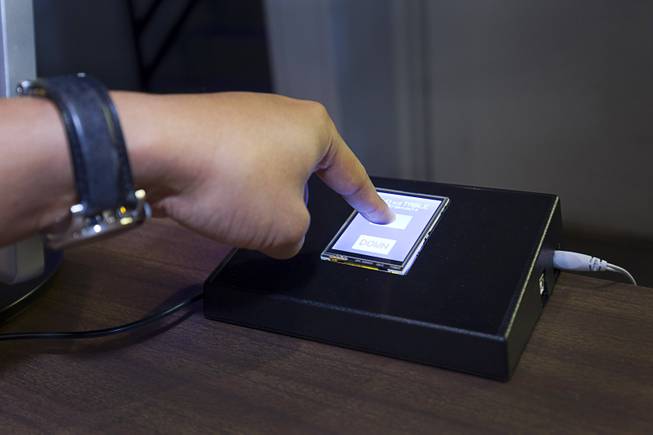
Joel Trubatch adjusts the height of a desk outfitted with an AdusTABLE during the Fred and Harriet Cox Senior Design Competition at UNLV Thursday, May 7, 2015. The AdusTABLE converts a normal desk into an adjustable-height desk that can be raised and lowered.
It looks like an ordinary table, and that’s the point. The mechanical engineering students who designed AdjusTABLE said they wanted to combine the productivity of a standing desk with the personalized appeal of a traditional office desk. So they attached a set of actuators to the sides of a regular office desk and clamped steel supports underneath. At the touch of a button, users can raise and lower the desk at will. (A built-in timer will also tell you when you’ve been sitting down for long.)
“When we were looking at desks, we thought, 'It’s already here, let’s just try to rig it up,'” said Arvi Balbin.
Production cost: Around $800 | Designed by Arvi Balbin, Lakiesha Hampton and Jericha Mendoza
Recoil
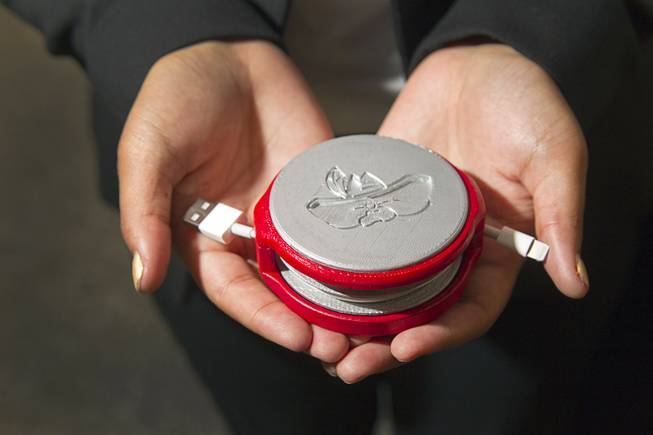
Jennifer Bateau shows off the Recoil during the Fred and Harriet Cox Senior Design Competition at UNLV Thursday, May 7, 2015. The Recoil allows smartphone owners use the cable that comes with the phone and turn it into a retractable cable.
In a rush, people often cram their iPhone or Android charging cables into purses, backpacks and other places where they can get jostled around and sometimes destroyed. Aftermarket cable managers often require users to purchase completely new cords, but three students had a better solution: Invent a handheld device that automatically stores the cable. Thus was born Recoil.
With Recoil, users thread their cable through an opening in a small plastic disk, press a tab and a spring spins the disk, sucking the wire neatly inside the container.
“We wanted to make something that we as students would use,” said Jennifer Bateau. “People on the go always carry their chargers around.”
Production cost: $17 ($9 with mass production) | Designed by Ajericho Malia, Carl Ajuziem and Jennifer Bateau
Particle P.O.D.
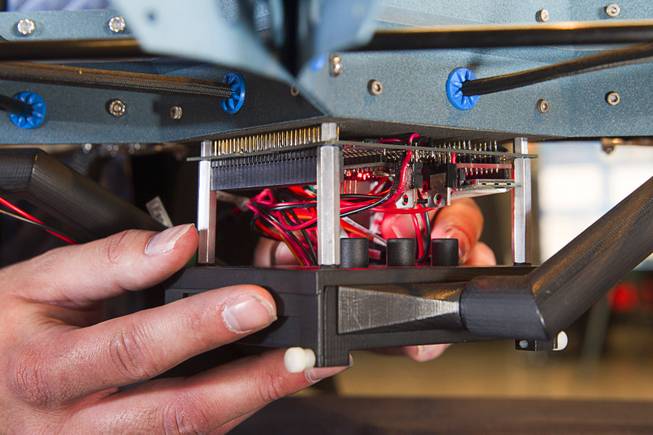
A Particulate P.O.D. is shown under a Skyworks Aerial Systems drone during the Fred and Harriet Cox Senior Design Competition at UNLV Thursday, May 7, 2015. The particulate sensor combined with the drone allows for remote monitoring of air quality.
If the P.O.D. looks familiar, that’s because it uses technology developed in a previous Senior Design Competition. It’s based on the Qua.R.K., a quadcopter drone designed by former UNLV engineering students Greg Friesmuth and Jinger Zeng and produced by their new company Skyworks Aerial Systems. The two students who made the P.O.D. bought one Qua.R.K. and rigged a $600 air particle sensor onto it. Sounds simple, but it hopes to avoid the high costs of installing permanent stations to monitor air quality. With a drone, air quality can be measured anywhere — even indoors — for a much lower price.
“It’s a mobile solution you can pretty much put anywhere and gather data,” said Christopher Phillips.
Production cost: $5,928.75 (the drone accounts for $5,000) | Designed by Christopher Phillips and Eduardo Hoyeula-Alcaraz
Wet Strip
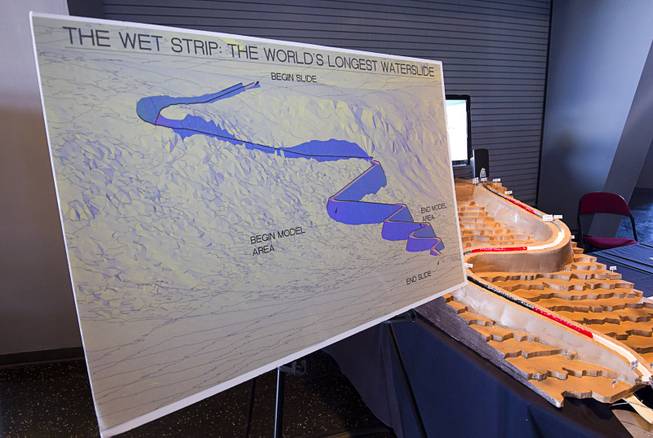
A illustration of the Wet Strip water slide is displayed during the Fred and Harriet Cox Senior Design Competition at UNLV Thursday, May 7, 2015. The slide, if built, will be the longest water slide in the world. (The model, background, shows only a portion of the slide.)
Civil and environmental engineering students set out to find another way to entertain tourists during the blistering Las Vegas summer. They settled on a 2,500 foot water slide built into the side of a mountain. Sounds ambitious, but the students based it on the same principles used to design concrete flood channels. The ride, which they say would give tourists a good reason to drive all the way to Wet N’ Wild in the southwest valley, lasts a three full minutes, reaches a top speed of around 25 mph and involves an elevation change of 350 feet — or it would if Wet N’ Wild decided to build it. The students’ only prototype right now is a small table model.
“This would be about 600 feet longer than the longest water slide,” said Scott Booth. “You could design it other places and even go higher if you wanted.”
Production cost: $4.2 million | Designed by Mark Martini, Scott Booth, Anthony Muriuki and Andy Rezazadeh
Autonomous Security Rover
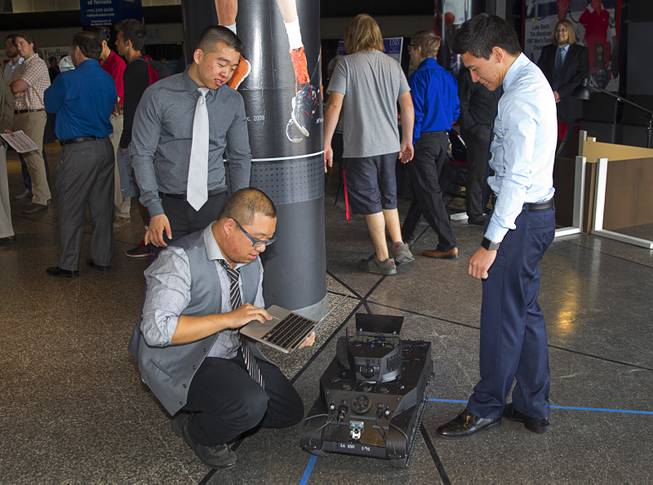
Tony Teoh, standing left, Rong Xue, center, and Brian Kieatiwong work on their Autonomous Security Robot after blowing a Bluetooth module during the Fred and Harriet Cox Senior Design Competition at UNLV Thursday, May 7, 2015. The robot uses localized tracking and can travel autonomously to the designated coordinates even if the Wi-Fi signal is lost, students said.
Skip this one if you currently work as a security guard, because electrical and computer engineering students have figured out a way to replace you. They took a big remote-control toy tank and stuffed it full of infrared sensors, GPS equipment and a camera. By preprogramming coordinates into a computer, the bot can automatically navigate around a house or business while avoiding obstacles and streaming video. If it’s connected to an alarm system, it can automatically move to wherever an intrusion is detected.
“Autonomy is a big thing now, especially in cars,” said Brian Kieatiwong. “A lot of people have been asking if we can put a gun on it.”
Production cost: around $900 (one professional security bot currently on the market costs $4,500 a month) | Designed by Brian Kieatiwong, Tony Teoh and Rong Xue
And that’s not all. Other student designs include a precision T-shirt cannon, an efficient thruster for low-orbit satellites and an electric hookah heater.
The winning design will be chosen by a panel of judges, with cash prizes for the best designs and award in categories like sustainability and commercial appeal.

Join the Discussion:
Check this out for a full explanation of our conversion to the LiveFyre commenting system and instructions on how to sign up for an account.
Full comments policy